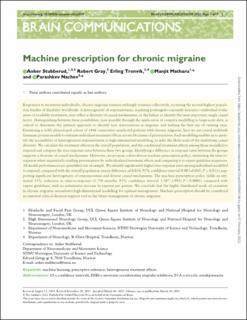| dc.description.abstract | Responsive to treatment individually, chronic migraine remains strikingly resistant collectively, incurring the second-highest population burden of disability worldwide. A heterogeneity of responsiveness, requiring prolonged—currently heuristic—individual evaluation of available treatments, may reflect a diversity of causal mechanisms, or the failure to identify the most important, single causal factor. Distinguishing between these possibilities, now possible through the application of complex modelling to large-scale data, is critical to determine the optimal approach to identify new interventions in migraine and making the best use of existing ones. Examining a richly phenotyped cohort of 1446 consecutive unselected patients with chronic migraine, here we use causal multitask Gaussian process models to estimate individual treatment effects across 10 classes of preventatives. Such modelling enables us to quantify the accessibility of heterogeneous responsiveness to high-dimensional modelling, to infer the likely scale of the underlying causal diversity. We calculate the treatment effects in the overall population, and the conditional treatment effects among those modelled to respond and compare the true response rates between these two groups. Identifying a difference in response rates between the groups supports a diversity of causal mechanisms. Moreover, we propose a data-driven machine prescription policy, estimating the time-to-response when sequentially trialling preventatives by individualized treatment effects and comparing it to expert guideline sequences. All model performances are quantified out-of-sample. We identify significantly higher true response rates among individuals modelled to respond, compared with the overall population (mean difference of 0.034; 95% confidence interval 0.003–0.065; P = 0.033), supporting significant heterogeneity of responsiveness and diverse causal mechanisms. The machine prescription policy yields an estimated 35% reduction in time-to-response (3.750 months; 95% confidence interval 3.507–3.993; P < 0.0001) compared with expert guidelines, with no substantive increase in expense per patient. We conclude that the highly distributed mode of causation in chronic migraine necessitates high-dimensional modelling for optimal management. Machine prescription should be considered an essential clinical decision-support tool in the future management of chronic migraine. | en_US |

